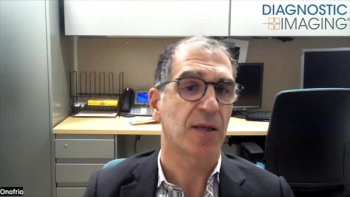AI Radiology ROI Calculator Study Projects 451 Percent ROI Over Five Years
Incorporating an artificial intelligence (AI) platform into the radiology workflow at a stroke management-accredited hospital may lead to projected savings of 78 days in triage time and 41 days in reporting time for radiologists over a five-year period, according to new research.
A savings of 41 days in radiologist reporting time and a 470 increase in intracranial hemorrhage (ICH) diagnoses are a couple of the projected five-year benefits suggested by new research looking at the use of a return on investment (ROI) calculator for assessing integration of an artificial intelligence (AI) platform into a hospital’s radiology workflows.
For the study, recently published in the
Using the ROI calculator, which was originally developed in Microsoft Excel, the study authors compared the Calantic AI platform (including a total of 14 AI applications for neurology and thoracic indications) to projected radiology workflows without AI over one- and five-year periods, according to the study. The researchers noted the ROI calculator included annual estimates of X-ray, computed tomography (CT) and magnetic resonance imaging (MRI) scan volumes.
Over a five-year period, the study authors projected that the AI platform would result in a total time savings for radiologists of 145 days, including 78 days in triage time, 41 days of reporting time, 16 days of waiting time and 10 days of reading time.
“ … The (ROI) calculator highlighted significant efficiency gains, such as automating tasks, reducing interpretation time, and enhancing accuracy. These benefits contribute to increased radiologist activity, reduced turnaround time for reports, improved patient care, and avoidance of costly litigations from missed diagnoses,” wrote lead study author Prateek Bharadwaj, MS, MBA, a global market access manager-radiology for Bayer, and colleagues.
The researchers estimated that incorporation of the AI platform could lead to a five-year increase in diagnosis for incidental pulmonary nodules (IPNs) in 678 more cases with 462 estimated imaging follow-up exams. They also projected five-year increases in large vessel occlusion (LVO) detection for 196 cases and ICH detection for 470 cases with 431 additional hospitalizations for stroke.
“Reprioritization of stroke cases led to shorter hospitalization, resulting in 246 less hospital days for patients with ICH. Although the platform led to an increase in number of hospitalizations due to additional diagnoses, it may have contributed to a reduction in hospital length-of-stay due to earlier diagnoses,” noted Bharadwaj and colleagues.
Including time-related savings, clinical outcomes, projected revenue of $3,560,959 and total costs of $1,780,480 associated with the AI platform over a five-year period, the researchers a 451 percent ROI.
In their study, the researchers noted that downstream hospitalizations and procedures associated with use of the AI platform were significant drivers of ROI in the hospital setting. They pointed out that assessing indirect benefits of AI would be more of a consideration for imaging centers not associated with hospitals given lower projected revenues for treatment interventions.
“This emphasizes the need to consider indirect effects comprehensively to fully capture the financial benefits of AI technology across different institutions,” added Bharadwaj and colleagues.
In regard to study limitations, the researchers said the ROI calculator used in the study did not account for indirect benefits such as impacts on radiologist burnout or the facility’s reputation. The ROI calculator also did not consider false positive or false negative diagnoses that may have resulted from AI applications, or impacts upon future reimbursement, according to the study authors. They also conceded a number of assumptions with the development of the ROI calculator, including cost estimates based on projections of three to 10 percent annual increases in scan volume, and equivalency of reading times, additional diagnoses and hospitalization reimbursement for large vessel occlusion and intracranial hemorrhage.
Newsletter
Stay at the forefront of radiology with the Diagnostic Imaging newsletter, delivering the latest news, clinical insights, and imaging advancements for today’s radiologists.





























